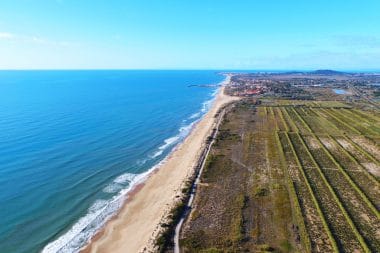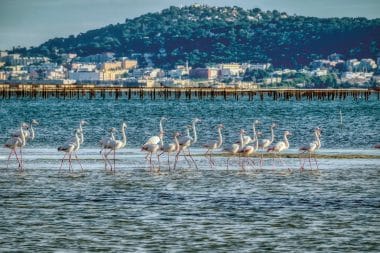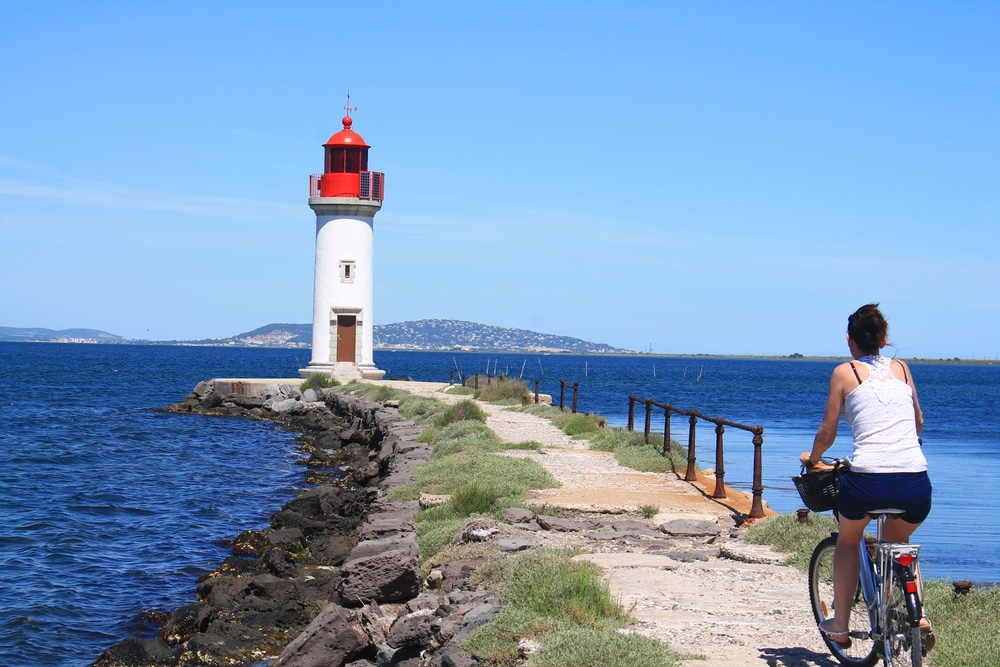Picturesque freshwater lagoon surrounded by unspoiled nature
The names of the cities sound very similar, and both destinations are located in the south of France on the Mediterranean coast. Nevertheless, the small Marseillan Plage should not be confused with the French metropolis of Marseille. Marseillan Plage is located 210 kilometers west of Marseille, about 50 kilometers from Montpellier, and close to the Spanish border. The fishing village, which is quite small with less than 8,000 inhabitants, is picturesquely located on the Étang de Thau lagoon. Since 1947, the place has borne the official title of “seaside resort”. In addition to beach vacationers and water rats, all nature lovers also get their money’s worth here. In the vicinity of the city there are numerous nature parks, such as the Haut-Languedoc Nature Park or the Camargue Nature Park, which invite you to go on excursions.
Relaxation, seafood and boat tours on the Étang de Thau

The Étang de Thau lagoon has a circumference of 55 kilometres. Marseillan Plage, as well as the towns of Mèze, Sète, Bouzigues and Balaruc-les-Bains, is located directly on this freshwater lagoon, which is separated from the sea by a sandbank. The lagoon is fed with fresh water from the Pyrenees. Around the beaches of the Étang de Thau, tourists will find a variety of water sports facilities. In all cities there are, for example, sailing, surfing and diving schools. You should definitely try the oysters farmed in the region in one of the idyllic beach bars. In addition to tourism, the locals live from fishing, which is also reflected in the menus of the Étang de Thau. The Tielles, delicious dumplings filled with squid in tomato sauce, or the braised squid called rouille, are also delicious. If you would like to see the lagoon from the water, you can take a boat tour, which leads to the oyster beds of the Étang de Thau, among other places.
Excursion to Sète, the Venice of Languedoc
With just under 45,000 inhabitants, Sète is by far the largest town on the Étang de Thau. The city is also called the Venice of Languedoc, and that’s no coincidence. In the center of Sète is the Canal Royal, which has a Mediterranean feel with Italian influences. Here you can walk past bars, restaurants and small shops, cross a total of twelve bridges on a walk through the city, and marvel at box-like apartment buildings with colorful facades. The fishing port is particularly worth seeing. Here it is also very worthwhile to stop in one of the small restaurants and taste the freshly caught seafood. Mont Saint-Clair is considered the highest point in the city at 183 meters. From here you have a magnificent view over the city and out to the Mediterranean Sea. In the Espace Georges Brassens, the chanson singer Georges Brassens, who has cult status in France , is commemorated. The Musée Paul Valéry is equally interesting inside and out. The museum, which was built in the 1960s, is one of the Corbusier buildings. In addition to an exhibition on the city’s history, there is also a tribute to one of the city’s most famous sons: Paul Valéry, a well-known poet and philosopher. There is also a maritime museum and several galleries to visit. The many lighthouses, such as the Pointe des Onglous, which line up along the canal around Sète, are picturesque.
Pink flamingos and white horses in the Camargue Natural Park

The Camargue Natural Park is located about 40 kilometres east of Marseillan Plage, in the delta of the Rhône. The area around the Camargue Natural Park is very sparsely populated, which is why visitors encounter pure nature here. The wetland consists of sea salt flats, rice fields, reeds, swamps and ponds. A large population of pink flamingos can be found here. A number of other waterfowl also settle here. A little further inland, a heathland dominates, where bulls and the well-known white Camargue horses can be found.
Active across the Haut-Languedoc Nature Park
Only about 20 minutes by car from Marseillan Plage, the Haut-Languedoc Nature Park attracts all nature lovers who want to discover the exciting flora and fauna of the south of France in addition to high peaks and lakes. The region has a Mediterranean climate, rain rarely falls. More than 2,500 plant species, such as sundews and black cumin, downy oaks and Douglas firs can be found here. Rare animal species such as the Bonelli eagle, otter, mouflon and genet can also be found here. Hikers climb the Massif de l’Espinouse, from where you have a breathtaking view of the surrounding mountain peaks. There are numerous well-marked hiking and mountain biking routes that lead through the 260,000-hectare area. You always pass turquoise lakes, deep gorges, wide valleys, numerous peaks and picturesque villages where time seems to stand still. In addition, forest landscapes alternate with moors and meadows. At 1,211 metres, the Pic de Nore is the highest peak in the Haut-Languedoc Natural Park. Climbing routes have also been designated and tested. The mountain lakes of Raviège and Avène are wonderful for swimming on hot summer days.
The Reserve Naturelle Nationale du Bagnas
Within walking distance of Marseillan Plage is the Reserve Naturelle Nationale du Bagnas, one of the most important bird sanctuaries in France. 250 different bird species cavort here, such as the little grebe, the spoonbill, various swallow species, songbirds, birds of prey and waders. Guided tours of the protected area are offered in different languages. On foot, and by bike, however, you can also set off on your own. It goes past salt marshes, artificially created ponds and swamps, through forests, meadows and vineyards.


